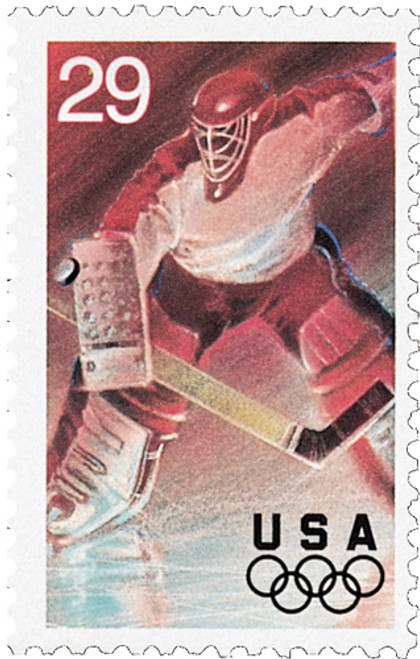
1994 29c Winter Olympics
# 2807-11 - 1994 29c Winter Olympics
$3.00 - $25.00
U.S. #2807-11
29¢ Winter Olympics
29¢ Winter Olympics
Issue Date: January 6, 1994
City: Salt Lake City, UT
Quantity: 35,800,000
Printed By: Ashton-Potter
Printing Method: Lithographed
Perforations: 11.2
Color: Multicolored
City: Salt Lake City, UT
Quantity: 35,800,000
Printed By: Ashton-Potter
Printing Method: Lithographed
Perforations: 11.2
Color: Multicolored
A breathtaking sport, downhill or Alpine skiing is a test of speed and skill as competitors race over a course at up to 65 miles per hour. An Olympic event since 1936, Alpine skiing consists of five different contests: downhill, slalom, giant slalom, super giant slalom, and the combined.
A test of high-speed skiing, the downhill is run on a course, that for men drops 800 to 1,000 meters. A skilled downhill racer can complete the course in 1 1/2 to 2 minutes. The slalom challenges the skier’s skill in high-speed turns. A series of numbered gates are set up so that the racers must make many turns, skiing in a zig-zag fashion.
Combining the elements of the downhill and the slalom, the giant slalom requires both speed and the ability to make high-speed turns. The super giant slalom is a cross between the downhill and the giant slalom. And the combined competition consists of a downhill race and a slalom. Although the two events are always held at the same location, they often take place on different days.
Women also compete in these events, although at shorter distances and on courses with less of a vertical drop.
The Olympic Games
First held in Olympia in 776 B.C., the Olympic Games played an important role in ancient Greece. Held every four years, the games continued until A.D. 393 when the Roman Emperor Theodosius halted them for religious reasons and tore up the stadiums.
In 1894, Baron de Coubertin, a Frenchman, revived interest in the Games with his idea of organizing a modern, international Olympics. Believing athletics played a major role in forming a person’s character, he also hoped the Games would promote world peace. In 1896 the first modern Olympics were held in Athens, Greece. The Winter Games were added in 1924.
Today the Olympics continue to bring together the world’s finest athletes. No other sports event attracts so much attention, as millions around the world share in the triumphs and tragedies of these courageous athletes.
Lugeing
A relatively new Olympic event, lugeing was included in the Winter Games for the first time in 1964. A traditional winter sport in Austria, it dates back to the 16th century. The term luge comes from the French word for a small sled. Lying on their backs, lugers race feet first down a steeply banked ice-covered course. The driver steers by using his feet, shifting weight, and pulling on straps attached to the runners.
Ice Dancing
Gliding over the ice so gracefully and effortlessly, ice dancers often leave their audience spellbound. Combining skating with ballroom dancing, ice dancing differs from pair skating in several ways.
In ice dancing the couple may separate only briefly to change direction or position. Movements of strength and daring skill which are inconsistent with dance, particularly lifts and jumps, are not allowed. And each partner must keep at least one skate on the ice, except during brief lifts and spins when the woman may have both skates off the ice.
In ice dancing competition, the couple must perform in three events: compulsory dances, original set pattern dances, and free dancing. In compulsory dances the couple must perform two particular dances to the same music. These dances must be performed according to official diagrams. In the original set pattern dance the couple may choose their own steps and music, however they must follow a certain dance rhythm set in advance. In free dancing the couple may select their own music and combinations of movements.
Originating in 1880 Austria, when the Vienna Skating Club adapted the waltz, ice dancing became an Olympic event in 1976.
Cross Country Skiing
An important means of transportation, cross-country skiing dates back thousands of years. The term Nordic refers to northern Europe, where in countries such as Sweden, Norway, and Finland, cross-country skiing is still a practical means of travel in the winter.
During the 1900s skiing gained popularity both as a recreational and a competitive sport. And in 1924, Nordic competitions were included in the first Winter Olympic Games. A grueling test of strength and endurance, cross-country racing requires courage, determination, and stamina.
Like Alpine skiing, Nordic skiing also consists of several different contests: cross-country races, relays, jumping, and the biathlon. Cross-country races take place on a course that is equally divided between uphill, downhill, and flat surfaces. Skiers race against the clock - the one with the fastest time wins. Relays are team competitions, where each member of the team races an equal distance. Jumping, a popular spectator sport, often attracts up to 200,000 spectators. Contestants receive points for both the length of the jump and the style with which it was executed. The biathlon combines cross-country skiing with riflery as skiers shoot at targets set up along the course.
Ice Hockey
The fast, rough action of ice hockey makes it one of the most exciting sports to watch. Players flash up and down the ice, and with powerful swings send the puck traveling at speeds of up to 100 miles per hour. Canada’s national sport, the game has become popular in other countries including Czechoslovakia, the Soviet Union, Sweden, and the United States.
First played in Montreal in 1855, ice hockey most likely began as a variation of field hockey. Students at Montreal’s McGill University drew up the first formal rules for the game in 1870. As the rules became widely distributed, the popularity of the sport grew, and soon teams began cropping up across Canada. In fact by 1893 the game had become so popular that Canada’s governor-general Baron Stanley donated a silver bowl to be awarded annually to Canada’s champion hockey team. The Montreal team became the first to win the coveted Stanley Cup.
Two years later the first ice hockey game was played in the U.S., and by 1903 the first professional team had been organized at Houghton, Michigan. In 1920 the first amateur world championships were held as part of the Olympic Games, marking the beginning of Olympic ice hockey competition.
U.S. #2807-11
29¢ Winter Olympics
29¢ Winter Olympics
Issue Date: January 6, 1994
City: Salt Lake City, UT
Quantity: 35,800,000
Printed By: Ashton-Potter
Printing Method: Lithographed
Perforations: 11.2
Color: Multicolored
City: Salt Lake City, UT
Quantity: 35,800,000
Printed By: Ashton-Potter
Printing Method: Lithographed
Perforations: 11.2
Color: Multicolored
A breathtaking sport, downhill or Alpine skiing is a test of speed and skill as competitors race over a course at up to 65 miles per hour. An Olympic event since 1936, Alpine skiing consists of five different contests: downhill, slalom, giant slalom, super giant slalom, and the combined.
A test of high-speed skiing, the downhill is run on a course, that for men drops 800 to 1,000 meters. A skilled downhill racer can complete the course in 1 1/2 to 2 minutes. The slalom challenges the skier’s skill in high-speed turns. A series of numbered gates are set up so that the racers must make many turns, skiing in a zig-zag fashion.
Combining the elements of the downhill and the slalom, the giant slalom requires both speed and the ability to make high-speed turns. The super giant slalom is a cross between the downhill and the giant slalom. And the combined competition consists of a downhill race and a slalom. Although the two events are always held at the same location, they often take place on different days.
Women also compete in these events, although at shorter distances and on courses with less of a vertical drop.
The Olympic Games
First held in Olympia in 776 B.C., the Olympic Games played an important role in ancient Greece. Held every four years, the games continued until A.D. 393 when the Roman Emperor Theodosius halted them for religious reasons and tore up the stadiums.
In 1894, Baron de Coubertin, a Frenchman, revived interest in the Games with his idea of organizing a modern, international Olympics. Believing athletics played a major role in forming a person’s character, he also hoped the Games would promote world peace. In 1896 the first modern Olympics were held in Athens, Greece. The Winter Games were added in 1924.
Today the Olympics continue to bring together the world’s finest athletes. No other sports event attracts so much attention, as millions around the world share in the triumphs and tragedies of these courageous athletes.
Lugeing
A relatively new Olympic event, lugeing was included in the Winter Games for the first time in 1964. A traditional winter sport in Austria, it dates back to the 16th century. The term luge comes from the French word for a small sled. Lying on their backs, lugers race feet first down a steeply banked ice-covered course. The driver steers by using his feet, shifting weight, and pulling on straps attached to the runners.
Ice Dancing
Gliding over the ice so gracefully and effortlessly, ice dancers often leave their audience spellbound. Combining skating with ballroom dancing, ice dancing differs from pair skating in several ways.
In ice dancing the couple may separate only briefly to change direction or position. Movements of strength and daring skill which are inconsistent with dance, particularly lifts and jumps, are not allowed. And each partner must keep at least one skate on the ice, except during brief lifts and spins when the woman may have both skates off the ice.
In ice dancing competition, the couple must perform in three events: compulsory dances, original set pattern dances, and free dancing. In compulsory dances the couple must perform two particular dances to the same music. These dances must be performed according to official diagrams. In the original set pattern dance the couple may choose their own steps and music, however they must follow a certain dance rhythm set in advance. In free dancing the couple may select their own music and combinations of movements.
Originating in 1880 Austria, when the Vienna Skating Club adapted the waltz, ice dancing became an Olympic event in 1976.
Cross Country Skiing
An important means of transportation, cross-country skiing dates back thousands of years. The term Nordic refers to northern Europe, where in countries such as Sweden, Norway, and Finland, cross-country skiing is still a practical means of travel in the winter.
During the 1900s skiing gained popularity both as a recreational and a competitive sport. And in 1924, Nordic competitions were included in the first Winter Olympic Games. A grueling test of strength and endurance, cross-country racing requires courage, determination, and stamina.
Like Alpine skiing, Nordic skiing also consists of several different contests: cross-country races, relays, jumping, and the biathlon. Cross-country races take place on a course that is equally divided between uphill, downhill, and flat surfaces. Skiers race against the clock - the one with the fastest time wins. Relays are team competitions, where each member of the team races an equal distance. Jumping, a popular spectator sport, often attracts up to 200,000 spectators. Contestants receive points for both the length of the jump and the style with which it was executed. The biathlon combines cross-country skiing with riflery as skiers shoot at targets set up along the course.
Ice Hockey
The fast, rough action of ice hockey makes it one of the most exciting sports to watch. Players flash up and down the ice, and with powerful swings send the puck traveling at speeds of up to 100 miles per hour. Canada’s national sport, the game has become popular in other countries including Czechoslovakia, the Soviet Union, Sweden, and the United States.
First played in Montreal in 1855, ice hockey most likely began as a variation of field hockey. Students at Montreal’s McGill University drew up the first formal rules for the game in 1870. As the rules became widely distributed, the popularity of the sport grew, and soon teams began cropping up across Canada. In fact by 1893 the game had become so popular that Canada’s governor-general Baron Stanley donated a silver bowl to be awarded annually to Canada’s champion hockey team. The Montreal team became the first to win the coveted Stanley Cup.
Two years later the first ice hockey game was played in the U.S., and by 1903 the first professional team had been organized at Houghton, Michigan. In 1920 the first amateur world championships were held as part of the Olympic Games, marking the beginning of Olympic ice hockey competition.
















